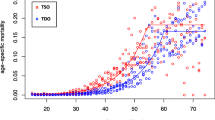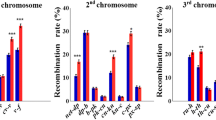Summary
Reverse and relaxed selection were carried out in sublines which were derived from six replicate lines of Drosophila during 86–89 generations of selection for increased abdominal bristle number, and the reverse selection sublines were reciprocally crossed with selection lines of their origin.
The results of serial relaxed selection initiated at different generations of selection confirm that the accelerated responses observed in the selection lines were largely due to deleterious genes, particularly lethals, with large effects on the selected character. The decline in mean bristle number under relaxed selection was not much different between crowded and uncrowded relaxed sublines.
Reverse selection initiated at generation 57 was very effective, though it failed to bring the mean back to the base population level, and the genetic differences between replicate sublines (two from each of the six lines) indicate that low bristle number genes were probably rare in the selection lines. The genes which were still segregating after 57 generations of selection, on the average, did not show any directional dominance. The contribution of the X-chromosome to selection response was proportional to its chromosome length.
Similar content being viewed by others
Literature
Al-Murrani, W.K.; Roberts, R.C. (1974): Genetic variation in a line of mice selected to its limit for high body weight. Anim. Prod. 19, 273–289
Clayton, G.A.; Robertson, A. (1957): An experimental check on quantitative genetical theory. 2: The long-term effects of selection. J. Genet. 55, 152–170
Falconer, D.S. (1960): Introduction to quantitative genetics. Edinburgh: Oliver and Boyd
Falconer, D.S. (1971): Improvement of litter size in a strain of mice at a selection limit. Genet. Res. 17, 215–235
Frankham, R. (1974): The nature of quantitative genetic variation in Drosophila. 2: Average dominance of abdominal bristle polygenes. Austr. J. Biol. Sci. 27, 683–686
Frankham, R.; Jones, L.P.; Barker, J.S.F. (1968): The effects of population size and selection intensity in selection for a quantitative character in Drosophila. 3: Analyses of the lines. Genet. Res. 12, 267–283
Hammond, K. (1973): Population size, selection response and variation in quantitative inheritance. Ph.D. Thesis, University of Sydney
James, J.W. (1971): The founder effect and response to artificial selection. Genet. Res. 16, 241–250
Nicholas, F.W. (1976): Forward and reverse response to artificial selection. Theor. Appl. Genet. 48, 101–104
Roberts, R.C. (1966): The limits to artificial selection for body weight in the mouse. Genet. Res. 8, 361–375
Robertson, F.W. (1955): Selection response and the properties of genetic variation. Cold Spring Harb. Symp. Quant. Biol. 20, 166–177
Wallace, B. (1968): Topics in population genetics. New York: Norton
Yoo, B.H. (1980a): Long-term selection for a quantitative character in large replicate populations of Drosophila melanogaster. 1: Response to selection. Genet. Res.
Yoo, B.H. (1980b): Long-term selection for a quantitative character in large replicate populations of Drosophila melanogaster. 3: The nature of residual genetic variability. Theor. Appl. Genet.
Author information
Authors and Affiliations
Additional information
Communicated by J.S.F. Barker
Rights and permissions
About this article
Cite this article
Yoo, B.H., Nicholas, F.W. & Rathie, K.A. Long-term selection for a quantitative character in large replicate populations of Drosophila melanogaster . Theoret. Appl. Genetics 57, 113–117 (1980). https://doi.org/10.1007/BF00253881
Received:
Accepted:
Issue Date:
DOI: https://doi.org/10.1007/BF00253881




